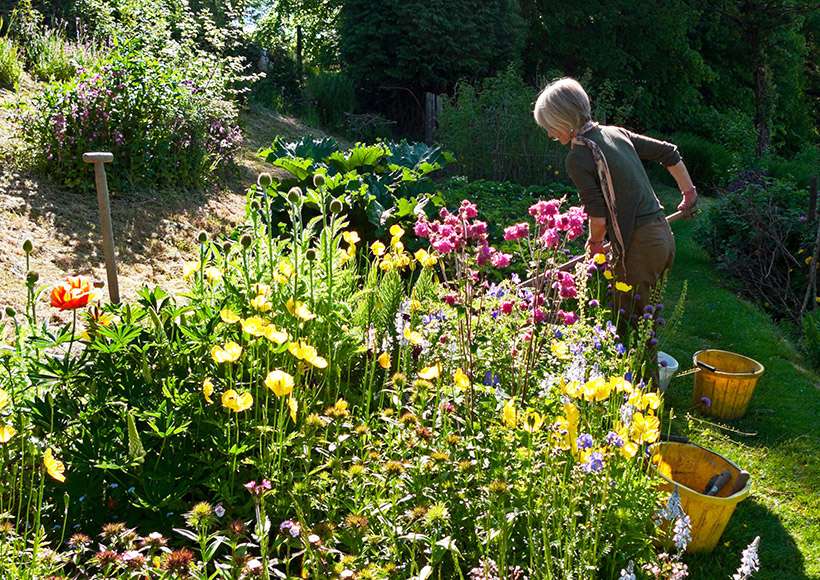Wildlife gardening
22.1 October 2020
“The big issues that face us, seem beyond our personal scope. Anything I might do to prevent climate change, stop the felling of rain forests, or prevent the hunting of rhinos…seems trivial and ineffective. It is all too easy to feel helpless and despondent. Much of my personal inspiration…comes from the small-scale victories I can achieve in my own garden.”
“For me saving the planet starts with looking after my own patch.”
“I have tried to gently steer the garden to support the most wildlife – to encourage bees and other pollinators by providing them with a banquet of flowers, and some quite places to nest or breed or hole up for the winter.”
“The foundations of a wildlife garden are…the plants.”
“The plants we choose to grow have a huge impact on the insects which will come to live on them or visit them.”
“Plants grow themselves and bees and butterflies will find them when they flower…herbivores will appear…and in turn predators will arrive to eat them.”
“Gardens with lots of plants…tend to have more insects.”
“Growing flowers…can provide food and lodging for a multitude of wild creatures. Tidy, or unkempt, a tiny courtyard or verdant rolling acres, your garden is probably already home to hundreds, maybe thousands of species.”
“Gardening can be truly green…
and I think it might just contain the key to saving the planet.”1

Garden power
22.2 October 2020
I was travelling by train recently idly looking at the passing landscape when I was struck by the realization that it was no longer a “green and pleasant land.”1 Since the so called “green revolution” of the 1950’s farming has been transformed into an industrial process in which food is produced on vast acres of monoculture crops in dead soil doused with fertilizers and toxic chemicals. As a result, many species of wild plants and animals have lost vital food and habitat and consequently suffered population declines across the British countryside.2
“There has been no let-up in the net loss of nature in the UK.”3
Both the abundance and distribution of many British wild species has declined since 1970. Surveys have shown that of the 8,431 species assessed using International Union for Conservation of Nature (IUCN) regional Red List criteria, 15% have been classified as threatened with extinction – and 2% are already extinct!3
There are similar long-term decreases of many UK insects – especially pollinators.4 Surveys over the period 1970 to 2015 show that overall populations declined by 10%. For example, since 1970 moths have declined by -25% and since 1976 butterflies have declined by -16%. Some 382 invertebrate – that is 11% of insect species surveyed – are now classified as being at risk of extinction in Britain.3
“Gardens are habitats where people can help make a difference to these alarming trends.”5
Thus, contrary to popular conception, biological desert now forms vast swathes of the British landscape and so, perhaps counterintuitively, the hope of preserving biodiversity now lies in the towns and cities. This is due to green areas such as parks, road and rail verges, the landscaped areas around factories or offices – and just as importantly the humble domestic garden.6
“Individual gardens may be quite small, but they add together to make large, vegetated areas in our cities.”7
In Britain, some 7% of the land area is now urbanised2 and gardens make up some 19-27% of the area of these towns and cities.7 About 87% of households have gardens – that is nearly 22.7 million gardens. These obviously vary in size – but the average is about 190m2. This adds up to a total area of 433,000 hectares (4,330 km2) of gardens spread across the UK.8 A range of studies have shown that these gardens contain a surprisingly high diversity of species – including many of conservation concern.2 Thus, although domestic gardens are small their large numbers mean that have enormous potential to help maintain and hopefully restore biodiversity6 – especially if we all play our part.
“Even the smallest…garden can provide a rich and valuable sanctuary for a whole host of wildlife.”9
There have been dramatic declines of wildlife, especially insects, across Britain. But there is hope – it lies in the potential of the millions of gardens across the country to help counteract some of the habitat losses that we have experienced over recent decades.10 So every one of us, whether we have a small patio or rolling acres,6 can contribute to saving wildlife in Britain.2
“By taking positive steps in our own gardens, no matter how small, together we can make a difference.”11
There are many ways we can better manage our gardens to encourage greater biodiversity. This may include activities ranging from feeding the birds to digging a wildlife pond7 – but perhaps the best way is simply choosing to grow wildlife friendly plants such as trees, shrubs and most importantly flowers.8 Individual gardens may be small, but combined they have an enormous potential in helping to reverse the trend of wildlife species declines and extinctions of across Britain.10 We need to recognise the vital importance of our gardens and work to transform them and together create a nationwide mosaic of habitats that encourage biodiversity.11
So, why not pull on your wellies, roll up your sleeves and get out there and make your garden wildlife friendly?

Planting for insects
22.3 October 2020
There are many small acts we can all undertake to enhance the biodiversity of our gardens1 – but perhaps the best way of helping invertebrate populations is choosing to grow insect friendly plants.2
“An abundance of invertebrates of all types equate to a healthy garden ecology.”3
Even small gardens can contain many hundreds of species of plants, animals, and insects.4 All are members of the garden community and play a vital role in maintaining a healthy and balanced ecosystem. Every garden contains many types of insects including: herbivores that feed on living plants, detritivores, that feed on decomposing animal or plant matter, omnivores, that eat both plants and insects and predators that eat other invertebrates.3
“Flowers…provide food resources, nectar and pollen for invertebrates.”5
Many flying insects such as butterflies, bees and hoverflies visit flowers for their nectar and pollen and perform an essential role in pollination. The problem is that the populations of some 1500 species of pollinators in the UK are in decline. These losses are mainly due to factors such as habitat loss and reduced food sources.6
“The best advice is to plant a variety of flowering plants in gardens, biased towards native and near native species with a careful selection of exotics to extend the flowering season.”5
Studies show that native plant species support the maximum number of different types of insects.3 Native plants are species that arrived in the British Isles without human intervention.5 Typically, however most domestic gardens consist of a mixture of native and near-native plants. The latter are species that occur naturally only in the Northern- Hemisphere but are not native to the British Isles.5 All can play an essential role in supporting biodiversity.5
It is also suggested that you add in a few exotics to your garden to extend the flowering season. Exotic plants are species occurring naturally only in the Southern Hemisphere.5
But whatever you choose, try to avoid highly bred cultivars with big double flowers – they may look pretty, but most contain little or no pollen or nectar and contribute nothing to the community of the garden.7
“The greater the variety of plants in a garden, the higher the diversity of invertebrates it will support.”8
Research has shown that diversity is an excellent “strategy for supporting pollinating insects”6 and is important in promoting insect abundance and species richness.5 So don’t limit your planting to a small range of species – try to plant a wide range of different plants.6 Also consider the seasons – and select a range of plants that flower throughout the year.6 Also try to include some evergreens in your garden, whatever their origin, as these provide essential winter shelter to insects.8
“The more densely you plant the more invertebrates your garden will support.”3
A high abundance and volume of vegetation in your garden also plays a key role – so plant generously and allow plants to fill all the spaces to maximise foliage density and cover.3 The plants you select will have a large impact on the insects which decide to come and live in your garden.4 There are many lists of recommended species on the internet that could be used to help you choose which to plant. Perhaps, the best know are those published by the Royal Horticultural Society under the general title of “Plants for Pollinators” These lists cover “Garden Plants”, “Wildflowers” and “Plants of the World” and can be found on the following link:
https://www.rhs.org.uk/science/conservation-biodiversity/wildlife/plants-for-pollinators
Together we could make a substantial difference and assist in reversing the dramatic decline of Nature in Britain – hope lies9 in the millions of gardens in our towns and cities.10 Our individual gardens may be small, but every one of them has the potential to provide food, shelter, and breeding sites for a wide range of animals.1 The actions we take – especially by growing insect friendly plants – can play an important role in retaining and enhancing insect populations and in rebuilding biodiversity in your garden.5
“Garden plants…support a wide range…of invertebrates.”3
So why not transform your garden? Take the time to select and plant seeds and grow a wide variety of suitable flowers that will bloom throughout spring, summer and autumn and provide insects with vital habitat and food.9 With this simple act you could transform your garden into a vibrant ecosystem and support hundreds of different insect species.4


